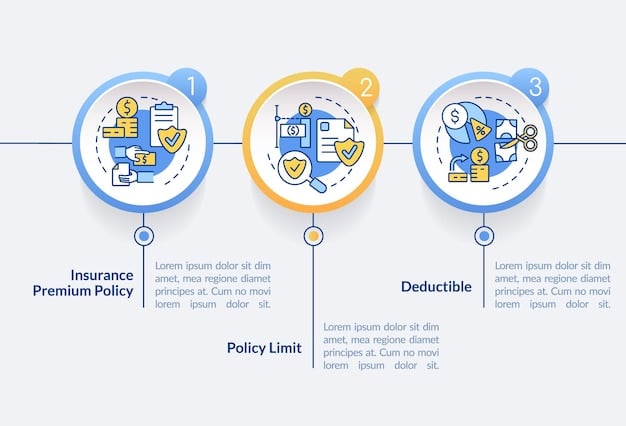Choosing the Right Health Plan in 2025: A Step-by-Step Guide

Choosing the right health plan in 2025 requires careful consideration of personal healthcare needs, budget, and available plan options, including understanding premiums, deductibles, and network coverage to ensure comprehensive and affordable healthcare.
Navigating the complexities of healthcare can be daunting, especially when it comes to choosing the right health plan in 2025. This comprehensive guide provides US residents with a step-by-step approach to making informed decisions about their healthcare coverage.
Understanding Your Healthcare Needs
Before diving into the specifics of different health plans, it’s crucial to understand your individual healthcare needs. This involves assessing your current health status, anticipated medical expenses, and preferred healthcare providers.
Assessing Your Health Status
Begin by evaluating your current health. Do you have any chronic conditions that require ongoing care? What types of medications do you take regularly? Understanding your current health status is the foundation for choosing the right health plan in 2025.
Estimating Future Medical Expenses
Consider any anticipated medical needs in the coming year. Are you planning any surgeries or medical procedures? Do you anticipate needing physical therapy or other specialized care? Estimating these expenses will help you determine the level of coverage you need.

To summarize, keep in mind the following key aspects related to understanding your healthcare needs:
- Chronic Conditions: Identify any existing conditions that require ongoing medical attention.
- Medications: List all prescription medications you currently take to estimate pharmacy costs.
- Anticipated Procedures: Note any planned surgeries, treatments, or therapies.
- Preventative Care: Consider the importance of routine check-ups and screenings for maintaining overall health.
By taking the time to assess your health status and estimate future medical expenses, you can narrow down your options and find a health plan that meets your needs and budget.
Exploring Different Types of Health Plans
The US healthcare system offers a variety of health plan options, each with its own set of features and benefits. Understanding these different types can help you make a more informed choice.
Health Maintenance Organizations (HMOs)
HMOs typically require you to choose a primary care physician (PCP) who coordinates your healthcare. You’ll generally need a referral from your PCP to see a specialist within the HMO network. Choosing the right health plan in 2025 might mean considering an HMO if you prefer coordinated care and lower out-of-pocket costs.
Preferred Provider Organizations (PPOs)
PPOs offer more flexibility than HMOs, allowing you to see specialists without a referral. However, you’ll usually pay more out-of-pocket for seeing providers outside of the PPO network. This is one factor that sets PPOs apart and is important to keep in mind when choosing the right health plan in 2025.
Exclusive Provider Organizations (EPOs)
EPOs are similar to HMOs in that you typically need to stay within the plan’s network to receive coverage. However, EPOs generally don’t require you to choose a PCP or obtain referrals to see specialists. Choosing the right health plan in 2025 may involve weighing the cost savings of an EPO against its network restrictions.
To recap, here’s a breakdown of the different health plan types:
- HMOs: Require a PCP and referrals for specialist visits. Often offer lower premiums and copays.
- PPOs: Offer more flexibility in choosing providers, but typically have higher out-of-pocket costs.
- EPOs: Usually don’t require a PCP or referrals, but coverage is limited to the plan’s network.
- Point of Service (POS) Plans: A hybrid of HMO and PPO plans, requiring a PCP but allowing out-of-network care at a higher cost.
Understanding the differences between HMOs, PPOs, and EPOs can make the choosing the right health plan in 2025 process easier. Each type offers different levels of flexibility and cost-sharing, so carefully consider which model best fits your needs.
Understanding Key Health Plan Terms
Navigating the world of health insurance requires familiarity with various key terms. Understanding these terms can help you better evaluate different health plans and make informed decisions.
Premium
The premium is the monthly payment you make to maintain your health insurance coverage. Premiums can vary widely depending on the plan’s level of coverage and your individual circumstances. When choosing the right health plan in 2025, it’s crucial to balance lower premiums with potentially higher out-of-pocket expenses.
Deductible
The deductible is the amount you must pay out-of-pocket for covered healthcare services before your insurance begins to pay. Understanding the deductible is essential, as a lower premium often comes with a higher deductible. Consider this tradeoff carefully when choosing the right health plan in 2025.
Copay
A copay is a fixed amount you pay for covered healthcare services, such as doctor visits or prescription refills. Copays are typically paid at the time you receive the service. Health plans with lower copays often have higher premiums to compensate. Knowing these tradeoffs is key when choosing the right health plan in 2025.

Here’s a summary of these important health plan terms:
- Premium: The monthly payment for your health insurance.
- Deductible: The amount you pay before your insurance starts covering costs.
- Copay: A fixed amount you pay for specific healthcare services.
- Coinsurance: The percentage of costs you pay after meeting your deductible.
By grasping the meaning of these fundamental health insurance terms, you can compare plans more effectively and make a choice that aligns with your financial situation and healthcare needs while choosing the right health plan in 2025.
Comparing Health Plans: What to Consider
Once you understand the different types of health plans and key terminology, it’s time to compare specific plans. Several factors should be taken into account to make the best choice.
Network Coverage
Ensure that your preferred doctors, hospitals, and specialists are included in the health plan’s network. Going out-of-network can result in significantly higher costs. When choosing the right health plan in 2025, checking network coverage is paramount.
Prescription Coverage
If you take prescription medications regularly, check the plan’s formulary to see if your medications are covered and at what cost. Some plans may have restrictions on certain medications. This is especially important to consider when choosing the right health plan in 2025.
Out-of-Pocket Maximum
Review the plan’s out-of-pocket maximum, which is the most you’ll have to pay for covered healthcare services in a year. A lower out-of-pocket maximum can provide peace of mind. When choosing the right health plan in 2025, consider this financial safety net.
Here are some key considerations when comparing health plans:
- Network: Verify that your preferred providers are in-network.
- Prescriptions: Check the formulary to ensure your medications are covered.
- Cost Sharing: Compare premiums, deductibles, copays, and coinsurance.
- Benefits: Consider additional benefits like vision and dental coverage.
By meticulously comparing these factors, you’ll be better equipped to select a health plan that meets your healthcare needs and budget considerations as you go about choosing the right health plan in 2025.
Utilizing Healthcare.gov and State Exchanges
Healthcare.gov and state exchanges are valuable resources for finding and enrolling in health insurance plans, particularly if you’re eligible for subsidies or financial assistance.
Navigating Healthcare.gov
Healthcare.gov allows you to compare plans, determine your eligibility for subsidies, and enroll in coverage. The website provides a user-friendly interface and extensive information about available plans. When choosing the right health plan in 2025, Healthcare.gov is often the first stop for many.
State Exchanges
Some states operate their own health insurance exchanges, which may offer additional plan options and resources. Check your state’s exchange to explore all available plans in your area. If you’re choosing the right health plan in 2025, your state exchange may offer more localized options.
Understanding Subsidies
Subsidies, also known as premium tax credits, can help lower your monthly health insurance premiums. Eligibility for subsidies is based on your income and household size. If you qualify, subsidies can make choosing the right health plan in 2025 more affordable.
Here are some tips for using Healthcare.gov and state exchanges:
- Create an Account: Start by creating an account on Healthcare.gov or your state’s exchange.
- Provide Accurate Information: Ensure the information you provide is accurate to determine your eligibility for subsidies.
- Compare Plans Carefully: Use the comparison tools to evaluate plans based on cost, coverage, and benefits.
- Enroll During Open Enrollment: Open enrollment is the period when you can enroll in or change health insurance plans.
By leveraging the resources available on Healthcare.gov and state exchanges, you can simplify the process of choosing the right health plan in 2025 and potentially save money on your healthcare coverage.
Making Your Final Decision and Enrolling
After thoroughly researching and comparing different health plans, it’s time to make your final decision and enroll. Before you commit, consider the following.
Reviewing the Summary of Benefits and Coverage (SBC)
The SBC provides a standardized summary of each plan’s benefits, coverage, and cost-sharing features. Reviewing the SBC can help you compare plans side-by-side and ensure you understand what you’re getting. When choosing the right health plan in 2025, the SBC is a crucial document.
Considering Your Budget
Evaluate the total cost of the plan, including premiums, deductibles, copays, and out-of-pocket maximums. Make sure the plan fits within your budget. This is a critically important step when you’re choosing the right health plan in 2025.
Enrolling in Your Chosen Plan
Once you’ve made your decision, follow the enrollment instructions provided by Healthcare.gov or your state exchange. Be sure to complete the enrollment process before the deadline. Successfully enrolling is the final, crucial milestone in choosing the right health plan in 2025.
Before finalizing your choice, consider these final steps:
- Read the Fine Print: Carefully review all plan documents to understand the terms and conditions.
- Confirm Enrollment: Ensure you receive confirmation of your enrollment from the insurance company.
- Keep Records: Keep copies of all plan documents and enrollment confirmations for your records.
By taking these final steps, you can confidently enroll in a health plan that provides the coverage you need at a price you can afford as you prepare for choosing the right health plan in 2025.
| Key Point | Brief Description |
|---|---|
| 🩺 Assess Needs | Evaluate health status & expected medical costs. |
| 🔍 Explore Plans | Understand HMOs, PPOs, EPOs and POS options. |
| 💰 Key Terms | Learn the meaning of Premium, Deductible, Copay. |
| 🌐 Compare | Check network, prescriptions, and out-of-pocket costs. |
Frequently Asked Questions
▼
The open enrollment period is the annual timeframe when individuals can enroll in or change their health insurance plans. It typically occurs in the fall, but exact dates can vary by state.
▼
Eligibility for a subsidy is based on your income and household size. When you apply for coverage through Healthcare.gov or your state exchange, your eligibility will be determined automatically.
▼
If you miss the open enrollment deadline, you generally cannot enroll in a health plan unless you qualify for a special enrollment period due to a life event, such as a job loss or marriage.
▼
A Summary of Benefits and Coverage (SBC) is a concise document that outlines a health plan’s key features, including covered benefits, cost-sharing, and limitations. It helps you compare plans easily.
▼
Typically, you can only change your health plan mid-year if you qualify for a special enrollment period. Otherwise, you must wait until the next open enrollment period to make changes.
Conclusion
Choosing the right health plan in 2025 involves careful consideration of your healthcare needs, budget, and available plan options. By following these steps and utilizing the resources available, you can find a plan that provides the coverage you need at a price you can afford.





